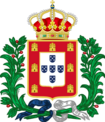This article relies largely or entirely on a single source .(June 2020) |
The topic of this article may not meet Wikipedia's general notability guideline .(October 2022) |


Duke of Viseu (in Portuguese Duque de Viseu) was a Portuguese Royal Dukedom created in 1415 by King John I of Portugal for his third male child, Henry the Navigator, following the conquest of Ceuta.
Contents
When Henry the Navigator died without issue, his nephew, Infante Ferdinand of Portugal (King Edward, King of Portugal's younger son), who was already Duke of Beja, inherited the Dukedom of Viseu and, when his younger son became King of Portugal as Manuel I, this became a royal Dukedom.
